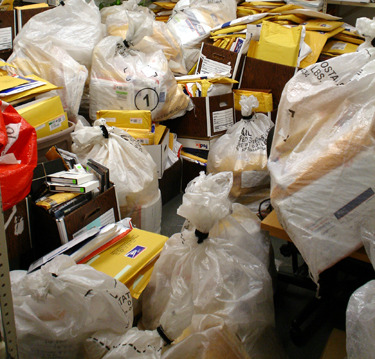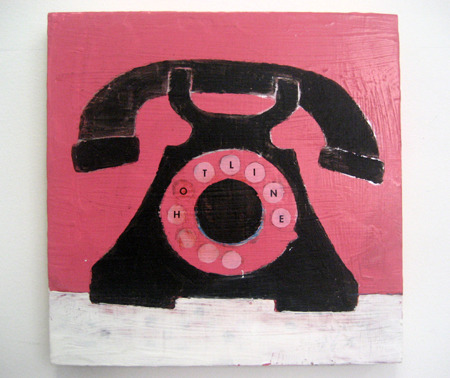The Business of Art: The Top 10 Questions
Chriss Slevin, Hotline (2005). Acrylic on wood. Collection of NYFA.
#1: Where can I go to find information on grants and residency programs?
The most comprehensive resource for individual artists is NYFA Source. This database is free and accessible online from NYFA’s website. It tracks over 8,500 programs available to US artists and covers all disciplines, including Dance, Design, Folk/Traditional, Literature, Music, Media, Performance/Interdisciplinary Art, Theater, and Visual Arts. It also contains programs useful to individuals working in arts-related professions as well as for teaching artists working within the field of arts in education.
For artists whose projects are fiscally sponsored by nonprofit organizations, the Foundation Center is a great place to find funding opportunities. There is a monthly fee to access their online directory—starting from $19.95 per month for the basic plan and up—or you can visit any one of their library locations throughout the country to use their database free from their computers. Also, contact your local public library to see if they have a subscription to the Foundation Center’s online directory that is available for free from their computer centers.
For resources about artist communities and artist-in-residence programs, visit the websites for the Alliance of Artists Communities, the Res Artis Network, and NYFA Source, where you can search for opportunities by discipline, location, as well as various other criteria.
#2: Writing grants and putting together application packages can be intimidating and difficult. Are there people or services that can help with the grantwriting and/or application process?
Yes. First, check to see if the organization is hosting a seminar for their prospective applicants. These information seminars are intended to discuss the program’s guidelines, provide further details about the decision and selection process, and answer any other relevant questions from artists.
Also, many nonprofit arts organizations offer courses (sometimes free) that give tips on grantwriting strategies, and where you can also ask in-depth questions to an experienced grantwriter.
There are also consultants who you can hire to help you with your writing and/or application. Since this may be a costly option—usually starting at no less than $30 per hour and up—it is best to seek recommendations or referrals to find the right person.
If you live in the New York area, our NYFA Learning program organizes Doctor’s Hours several times a year to give you the advantage of one-on-one meetings with curators and grantwriters. You can sign up for individual sessions, each lasting 20 minutes, where you can discuss your artist statement, portfolio, and project narrative with experienced professionals.
For those who want a quick guide to the grant writing process, the Queens Council on the Arts’ publication Grant Writing Basics is an excellent reference. You can download a PDF copy of this booklet for free from their website.
#3: What makes an artist eligible for an emergency grant?
Emergency cash grants or monetary awards are intended specifically for artists facing serious illness or catastrophic events or other unforeseen difficulties, such as major fires or life-threatening illnesses. These grants are usually not given to artists experiencing general financial hardship. Although some organizations award emergency “grants,” others may provide financial support on more informal, ongoing basis along with other in-kind supports and services.
#4: What other types of support are out there for artists aside from grants?
There are a vast number of services available to individual artists that can help facilitate your work by addressing a need or issue. Services are generally non-competitive programs (distinctive from grants and awards that tend to be competitive) for free or for hire. For example, you may need contacts or information regarding documenting your work or project, you may have legal questions related to contracts or copyright, or you might be in need of a new studio or practice space.
In NYFA Source, this information is gathered under the Services section of the search page. In addition, NYFA Classifieds provides recent service and opportunity postings related to the field.

Applications for NYFA’s Artists’ Fellowship Program in 2007. Photo: Frank Sonntag.
#5: As an individual artist juggling various jobs in addition to my artistic work, I am looking for health insurance options. Do you have any recommendations and suggestions for seeking out this information?
Certainly, artists of all disciplines—not just actors—should visit the Access to Health Insurance/Resources for Care website; it is the best place to begin researching health insurance providers and costs. This site, a service of The Actors’ Fund of America’s Health Insurance Resource Center, is a national service that gives options for each state in the country.
Also, Healthcare for Artists contains useful information on the Healthcare Reform Law in Massachusetts and proposed healthcare legislation, as well as additional news and resources pertaining to this topic.
#6: Help! I am a visual artist and am overwhelmed with all the administrative tasks related to my studio practice. Do you have any tips or is there a tool to help manage the studio operations so that I can dedicate more time to my artistic work?
Yes. There is a simple and easy to use software program call Getting Your Sh*t Together (GYST) which allows you to keep an inventory of your artwork, a virtual portfolio of your images, track your past exhibitions and related press releases, build your contact list for upcoming mailings, and account for project budgets and individual artwork prices, among many other features. It can even help you jump-start a grant application by making all of the elements you might need accessible in a click of the mouse. Digitizing your studio operations may take some time initially, but the convenient and organized records and documentation that will result make it worthwhile.
#7: How does an artist get into exhibitions? If I am invited to participate in a show, will the gallery pay for the framing and shipping of the work?
There are some great artist registries out there that can be helpful in getting your artwork seen and possibly selected for exhibitions. For example, Artists Space in New York has one of the most comprehensive registries, the Irving Sandler Artists File Online, which is open for artists around the world to include images and information about their work in and for curators to browse; there is no fee to join or use this service.
I also think it’s important for artists to see each other’s work and to be familiar with what your peers are working on. Word of mouth is still an excellent way for information on curators, gallerists, and upcoming exhibitions to be shared. Visual artists, for example, can often suggest parallel or interesting work by another artist, a reliable referral method for those who are organizing shows.
Also, NYFA’s Opportunities for Artists pages accept announcements like calls for proposals and competitions for commissions, both of which will raise the visibility of your artwork.
In most instances, artists should prepare to cover the cost of framing and shipping, although it never hurts to inquire whether the organizer will pitch in. Also, NYFA Source includes several grants that would help fund preperation fees or transportation.
#9: I need a practice space or a studio. Are there resources available to help me find that?
A: NYC Dance Spaces is an extremely useful free database of the city’s rehearsal and performance spaces for dancers, dance companies, and choreographers. It tracks information on spaces to rent, from studios to large venues, for ballet, jazz, tap, and modern dance.
For visual artists, the Lower Manhattan Cultural Council has two programs that are good to know about. The Workspace Residency Program provides artists and writers with a studio workspace for nine months, as well as access to a community of artists, professional development services, and a modest stipend. And their Swing Space program is a space grant program that connects artists and arts organizations with vacant commercial spaces downtown. Studio, rehearsal, office, installation, and exhibition space awards are typically for two to four months and are accompanied by a project stipend of $300-$3,000.
Also, to understand the logistics and legalities of whether to buy or lease a live/work, performing, presenting, or other type of space, check out Chicago Artist Resource’s Square Feet Program for information on affordable and appropriate options for your needs. Although the program is specific to artists in the Illinois area, it is a great reference on how to navigate this issue.
#9: What are some useful sources to get the word out about my upcoming project, performance, or exhibition?
Other than talking to your artist-peers and other people you have worked with in the past, try contacting your local arts council to ask if you can leave flyers and postcards at their office for people to take away. Ask around for relevant local listservs that might send out the announcement to their subscribers. If you are a member of a professional organization, they may be willing to email their constituency for you. There are also paid services that will send out email blasts to hundreds of recipients who are interested or involved in your field. And, posting in NYFA Classifieds is an easy and economical way for thousands of readers to see your announcement online.
#10: Is it true that having received a grant helps one to get others?
There is no rule that this is necessarily true, although like any other list of credentials on a resume a previous award helps establish a history of activity and acknowledgement from your field. Validation among peers is always a plus and a way for you to widen your network of support.
Linda J. Park is Program Officer, NYFA Source.





